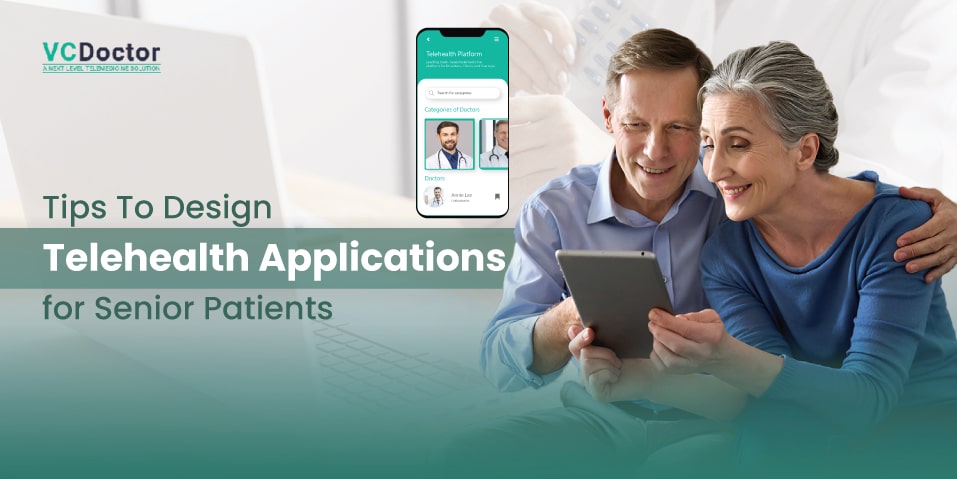Tips To Design Telehealth Applications for Senior Patients
Are you willing to help senior patients by providing them with a telehealth platform? In the advanced medical industry, everyone is investing in telehealth platforms to enhance patients’ experiences. Somewhere, senior citizens or old people find it more attractive and efficient to use telehealth application for their medical care. Although it’s beneficial in severe situations when they are alone and need medical care but cannot visit the clinic, it’s not beneficial in severe situations when they are alone and need medical care but cannot visit the clinic.
So, let’s consider developing a telehealth application that can improve the lives of senior patients. In this blog, we will discuss the necessary tips for creating an app dedicated to senior patients and the benefits of telehealth for older adults. Additionally, check out how to reach out to the best mobile app development company to create a customized mobile application that engages senior patients in using telehealth services.
Table of Contents
- Necessary Tips Consider While Developing Telehealth Applications for Senior Patients
- How to Build a Perfect Telehealth Application for Senior Patients
- Conclusion
- FAQs
Necessary Tips Consider While Developing Telehealth Applications for Senior Patients
1. Simple and Intuitive Interface
Telehealth apps for seniors require a simple and clear interface. Investors must focus on using large, easy-to-read buttons that are clearly labeled. This helps seniors with vision or dexterity issues and reduces the number of steps needed to complete tasks. Keep processes straightforward and eliminate unnecessary clicks and pages.
It makes the app easier to navigate and less confusing. By focusing on clarity and simplicity, seniors can confidently use the app to access healthcare services. Overall, this approach improves their experience and provides the best telehealth for elderly people. Moreover, it will also make the app user-friendly. This is a key factor in helping seniors stay engaged with their health care.
2. Clear Instructions
While designing a geriatric telemedicine app, investors need to provide clear instructions to help them use the app effectively. Start by providing guided tutorials that offer step-by-step instructions or walkthroughs. These tutorials clearly explain how to perform common tasks and navigate the app. Additionally, use tooltips or pop-up hints to explain features.
These small, on-screen notes can provide immediate guidance and clarify any confusing elements. By incorporating guided tutorials and helpful tooltips, seniors can learn to use the app with confidence and ease. This approach ensures they understand how to access the app’s features and manage their healthcare needs, improving their overall experience and satisfaction with the telehealth application.
3. Readable Text
Designing a telemedicine for elderly users requires readable text to ensure they can easily access information. Start by using large fonts for better readability, which is crucial for seniors who may have vision issues. The text should be big enough to be read without straining.
Additionally, ensure that high contrast between the text and the background is integrated. It will help users distinguish between dark text and light text on a dark background. Investors can focus on clarity and simplicity. Seniors can easily use the app with clarity to access healthcare services. It improves their overall experience and ensures they can effectively use the telehealth application to manage their healthcare needs.
4. Accessible Design
Accessible design features such as screen readers and voice commands are essential to enabling interaction for users with disabilities. Voice commands make it possible to operate software or devices just by speaking, which improves usability and removes the need for physical input—especially for people with restricted mobility. Therefore, telehealth access for seniors patients suffering from visually impaired people can help them navigate and access digital content thanks to screen readers, who translate text on screens into spoken words.
These characteristics are essential for guaranteeing inclusivity in technology, meeting a range of demands, and encouraging equitable access to data and communication resources. By implementing these functions, developers and designers contribute to a more user-friendly and accessible digital world where everyone may engage completely and efficiently.
5. Simple Login Process
A straightforward login process enhances user experience by implementing easy and secure authentication methods such as fingerprint or facial recognition. These methods not only simplify the login process but also bolster security by leveraging biometric data unique to each user.
Additionally, offering an option to stay logged in or remember credentials further streamlines access, reducing the need for frequent re-authentication without compromising security. This approach not only improves usability but also enhances user satisfaction. Moreover, by prioritizing simplicity and security in the login process, developers and designers contribute to a more user-friendly and efficient interface. Here, users can access their accounts conveniently and securely with minimal friction.
6. Reliable Technical Support
A stable technical support system is necessary to guarantee user happiness and quickly address problems. Providing customers with round-the-clock customer care ensures that help is accessible anytime they run into issues, building confidence and dependability in the offered solution. In addition to immediately resolving serious technical difficulties, this continuous availability also serves customers in different time zones or with varied schedules.
Additionally, telemedicine solutions for patients provide a variety of channels including chat, email, and phone improves accessibility and convenience by letting consumers select the mode of communication that best fits their needs or preferences. Whether calling for quick help, using chat to fix issues in real-time, or sending in-depth questions via email, users can anticipate prompt, efficient service that is catered to their specific needs.
7. Health Information Accessibility
Ensuring accessibility to health information involves providing easy access to medical records and history, enabling individuals to retrieve their health data effortlessly when needed. Organizing this information in a clear and understandable format further enhances accessibility, allowing patients and healthcare providers to navigate and interpret medical records effectively.
This approach not only improves patient empowerment and engagement but also supports informed decision-making and continuity of care. By prioritizing easy access and organized presentation of health information, healthcare systems and digital platforms contribute to better patient outcomes and healthcare delivery, promoting transparency and efficiency in managing personal health records.
8. Engaging and Interactive
Before creating an engaging app for users, it’s important to incorporate video tutorials that demonstrate how to navigate and utilize the app effectively. These tutorials provide visual guidance, making it easier for users to understand and master the various features available. Some investors question how to help the elderly users as well as engage them to take telehealth application.
Simply, integrating interactive elements such as reminders for medications and appointments enhances user engagement by offering practical tools that help users stay organized and on track with their health management. By combining instructional videos with interactive features, the app not only becomes more user-friendly but also empowers users to take control of their health routines efficiently and confidently.
9. Connectivity Features
Connectivity features enhance user experience by enabling family integration for accessing and monitoring health information. It guarantees smooth cooperation and assistance among family members in handling medical requirements. Furthermore, making it simple to communicate with medical professionals via the app promotes prompt and effective exchanges.
It enables users to voice concerns, get advice, and remain up to date on their health. By enabling users to maintain proactive health management and fostering continuity of care, these features leverage technology to close gaps in communication and improve overall healthcare results.
10. Security and Privacy
Staying private and secure is essential to managing health information. Data encryption shields patient data from unwanted access, guaranteeing its confidentiality. Furthermore, making privacy policies understandable to consumers aids in their understanding of how their data is handled and safeguarded.
Users are reassured that their privacy is a major priority and that trust is built through this transparency. Healthcare platforms may successfully protect sensitive data and uphold users’ right to privacy by emphasizing robust security protocols and transparent communication. This method not only safeguards data but also boosts user trust in the app’s dedication to upholding strict security and privacy guidelines. Additionally it also improves the doctors working with elderly patients in their daily routine.
11. Test with Seniors
To make sure the app is accessible for seniors to use, usability testing should be conducted with elderly patients to gather their feedback. It helps identify any difficulties they might encounter. Additionally, use an iterative design process, meaning you continuously improve the app based on the feedback received.
By regularly updating the app to address seniors’ needs and preferences, you ensure it stays user-friendly and effective for them. This approach not only enhances their experience but also boosts their satisfaction with the app, making it a valuable tool for managing their health.
How to Build a Perfect Telehealth Application for Senior Patients
Understanding Patient Demand
First of all, it is very important to understand the patients’ demands and note what they actually want through a telehealth platform. Senior citizens are very vulnerable, and there are many possibilities of having different illnesses. So, it is necessary to create telehealth for seniors that provide multiple services. Considering all the patients’ demands and requirements, investors should focus on creating an app that fulfills all the requirements and provides the best service.
Reaching Mobile App Development Company
Another important part of Mobile app development is finding the best company to build your business idea into a well-crafted app. You can connect with the top telehealth app development company or any telehealth portal that provides white-label service. White-label app development companies will create an app like their platform, which might look similar to it and have some function as per the investor’s requirement. Investors can customize or deduct the features, design, and compliance of the app as per their patients’ demands.
In other situations, they can also reach out to the top healthcare development company, which can develop the app according to your needs through top platforms like Flutter and React Native. Additionally, investors can also talk about time and budget planning so that you can receive your app within the deadline within your desired budget.
Deploying it to public use
At last, it’s time to deploy the app to the public so that patients can use it. Although this app is specifically made for senior patients, there is no age restriction for younger users as well. So, after completion, testing, and analysis, deploy your app to the Play Store on the App Store for the users. Moreover, it also provides a dedicated portion for customer reviews so that you can enhance your service and add necessary updates to your app as per the requirements of the patient. It is very important to update your app after a certain period so that you can bring more engagement and resolve the bugs and issues in your app.
Create a customize Telehealth platform for Elderly patients
Conclusion
Senior patients’ unique demands must be carefully taken into account when designing telehealth application in order to improve their experience and increase their access to healthcare. You may make an app that is easy and pleasurable for seniors to use by emphasizing a clear and simple interface, easy-to-read content, accessible design elements, and a simple login procedure. Reliable technical support, easy access to health information, and engaging, interactive features further enhance the app’s usability. Ensuring strong security like HIPAA compliance and privacy, incorporating connectivity features for family and healthcare provider communication, and testing with seniors to gather feedback are also crucial steps. Following these tips will help you develop a telehealth application that truly benefits senior patients.
FAQs
Q1 Why is a simple and intuitive interface important for seniors?
A simple and intuitive interface is crucial for seniors because it ensures that they can navigate the app easily without getting confused. Large buttons, clear labels, and straightforward processes help seniors with vision or dexterity issues use the app confidently and effectively.
Q2 How can clear instructions improve the usability of a telehealth app for seniors?
Clear instructions, such as guided tutorials and tooltips in telecare for the elderly users help them to understand how to use the app’s features step-by-step. It reduces the learning curve, enabling them to perform tasks independently and with confidence, which enhances their overall experience.
Q3 What role does readable text play in a Senior telehealth app?
Readable text is essential as many seniors have vision impairments. Using large fonts and high-contrast text improves readability, ensuring that seniors can easily access information without straining their eyes. It makes the app more accessible and user-friendly.
Q4 Why is it important to include connectivity features in a telehealth app for seniors?
Connectivity features, such as family integration and easy communication with healthcare providers, enhance the app’s functionality by ensuring seniors receive comprehensive support. These features enable family members to monitor health information and facilitate timely interactions with healthcare providers, improving the overall care experience.
Q5 How does usability testing with seniors improve the telehealth app?
Usability testing with seniors provides valuable feedback on any challenges they encounter while using the app. This feedback helps developers make necessary adjustments and improvements, ensuring the app meets seniors’ needs and preferences and making it more effective and user-friendly.





Woah! I’m enjoying the template/theme of this Blog.
It’s simple yet effective. A lot of times, it’s tough to get that “perfect balance” between user friendliness and appearance.
I must say that you’ve done a great job with this.
Also, the Blog loads very quick for me on Opera.
Superb Blog with excellent and informative content!
I’ve read this put up, and if I could, I
desire to recommend to you a few fascinating issues or suggestions.
By the way, the post is informative. thanks
Thanks for sharing tips for telehealth app development. The post is really informative.
Informative and essential tips to consider when planning to design a telehealth app. Thanks for sharing such kind of post.